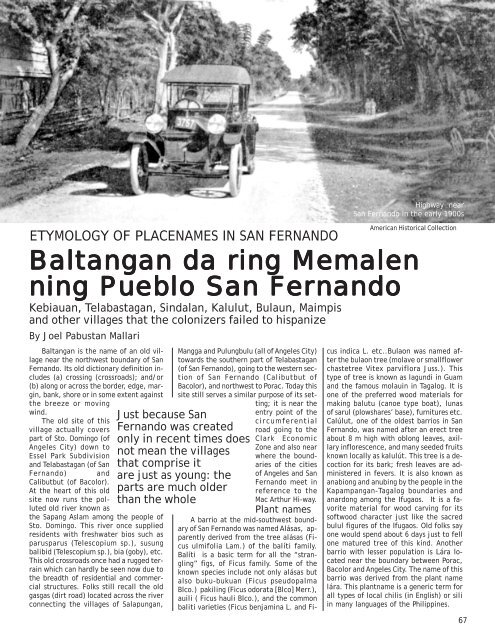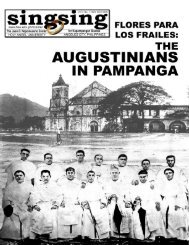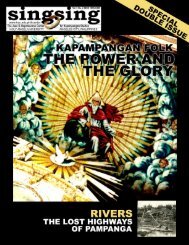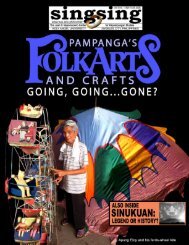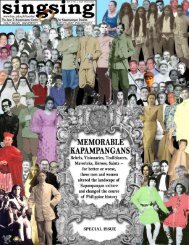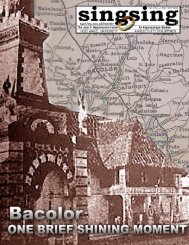Download PDF - Holy Angel University
Download PDF - Holy Angel University
Download PDF - Holy Angel University
Create successful ePaper yourself
Turn your PDF publications into a flip-book with our unique Google optimized e-Paper software.
ETYMOLOGY OF PLACENAMES IN SAN FERNANDO<br />
Baltangan is the name of an old village<br />
near the northwest boundary of San<br />
Fernando. Its old dictionary definition includes<br />
(a) crossing (crossroads); and/or<br />
(b) along or across the border, edge, margin,<br />
bank, shore or in some extent against<br />
the breeze or moving<br />
wind.<br />
The old site of this<br />
village actually covers<br />
part of Sto. Domingo (of<br />
<strong>Angel</strong>es City) down to<br />
Essel Park Subdivision<br />
and Telabastagan (of San<br />
Fernando) and<br />
Calibutbut (of Bacolor).<br />
At the heart of this old<br />
site now runs the polluted<br />
old river known as<br />
the Sapang Aslam among the people of<br />
Sto. Domingo. This river once supplied<br />
residents with freshwater bios such as<br />
parusparus (Telescopium sp.), susung<br />
balibid (Telescopium sp.), bia (goby), etc.<br />
This old crossroads once had a rugged terrain<br />
which can hardly be seen now due to<br />
the breadth of residential and commercial<br />
structures. Folks still recall the old<br />
gasgas (dirt road) located across the river<br />
connecting the villages of Salapungan,<br />
Highway near<br />
San Fernando in the early 1900s<br />
Baltang Baltangan Baltang an da da ring ring Memalen<br />
Memalen<br />
ning ning Pue Pueblo Pue lo San San F FFer<br />
F er ernando er nando<br />
Kebiauan, Telabastagan, Sindalan, Kalulut, Bulaun, Maimpis<br />
and other villages that the colonizers failed to hispanize<br />
By Joel Pabustan Mallari<br />
Mangga and Pulungbulu (all of <strong>Angel</strong>es City)<br />
towards the southern part of Telabastagan<br />
(of San Fernando), going to the western section<br />
of San Fernando (Calibutbut of<br />
Bacolor), and northwest to Porac. Today this<br />
site still serves a similar purpose of its setting;<br />
it is near the<br />
Just because San<br />
Fernando was created<br />
only in recent times does<br />
not mean the villages<br />
that comprise it<br />
are just as young: the<br />
parts are much older<br />
than the whole<br />
entry point of the<br />
circumferential<br />
road going to the<br />
Clark Economic<br />
Zone and also near<br />
where the boundaries<br />
of the cities<br />
of <strong>Angel</strong>es and San<br />
Fernando meet in<br />
reference to the<br />
Mac Arthur Hi-way.<br />
Plant names<br />
A barrio at the mid-southwest boundary<br />
of San Fernando was named Alásas, apparently<br />
derived from the tree alásas (Ficus<br />
ulmifolia Lam.) of the balíti family.<br />
Balíti is a basic term for all the “strangling”<br />
figs, of Ficus family. Some of the<br />
known species include not only alásas but<br />
also buku-bukuan (Ficus pseudopalma<br />
Blco.) pakiling (Ficus odorata [Blco] Merr.),<br />
auili ( Ficus hauli Blco.), and the common<br />
baliti varieties (Ficus benjamina L. and Fi-<br />
American Historical Collection<br />
cus indica L. etc..Bulaon was named after<br />
the bulaon tree (molave or smallflower<br />
chastetree Vitex parviflora Juss.). This<br />
type of tree is known as lagundi in Guam<br />
and the famous molauin in Tagalog. It is<br />
one of the preferred wood materials for<br />
making balutu (canoe type boat), lunas<br />
of sarul (plowshares’ base), furnitures etc.<br />
Calúlut, one of the oldest barrios in San<br />
Fernando, was named after an erect tree<br />
about 8 m high with oblong leaves, axillary<br />
inflorescence, and many seeded fruits<br />
known locally as kalulút. This tree is a decoction<br />
for its bark; fresh leaves are administered<br />
in fevers. It is also known as<br />
anabiong and anubing by the people in the<br />
Kapampangan-Tagalog boundaries and<br />
anardong among the Ifugaos. It is a favorite<br />
material for wood carving for its<br />
softwood character just like the sacred<br />
bulul figures of the Ifugaos. Old folks say<br />
one would spend about 6 days just to fell<br />
one matured tree of this kind. Another<br />
barrio with lesser population is Lára located<br />
near the boundary between Porac,<br />
Bacolor and <strong>Angel</strong>es City. The name of this<br />
barrio was derived from the plant name<br />
lára. This plantname is a generic term for<br />
all types of local chilis (in English) or sili<br />
in many languages of the Philippines.<br />
67


